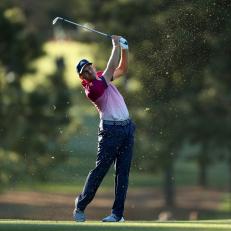Swing Sequence: 2017 Masters Champion Sergio Garcia
Nitpick if you must, but there's very little to dislike about this swingWhen you think of golfers whose swings stood the test of time, players such as Sam Snead and Tom Watson come to mind. But as Sergio Garcia defends his title at the Masters in April, it's becoming increasingly clear that his action should be mentioned among the all-time greats."There's real genius to the way he swings," says Golf Digest Teaching Professional Rob Akins. "He might be the best
ball-striker in the game today. That's not just my opinion. Ask guys out there on tour."Akins has been watching Garcia since his pro debut in 1999 and says only the most discernible eyes can recognize variance in Sergio's swing over the years."He's not as laid off, meaning the shaft doesn't flatten as much in the downswing," Akins says. "But what's more important is what he still does."Garcia's swing has always been dictated by his body pivot, Akins says. This might sound odd, but his arms and hands don't do much more than come along for the ride."There's no steering or stalling," he says. "He just pivots his body, stays behind the ball, and compresses it." —Ron Kaspriske
PRO-FILE: SERGIO GARCIA
AGE: 38 / 5-10 / 180 pounds
LIVES: Castellon, Spain
DRIVER: Callaway GBB Epic
BALL: Callaway Chrome Soft X“When he swings, it’s a lot like he’s cracking a whip.” —Rob Akins
AGE: 38 / 5-10 / 180 pounds
LIVES: Castellon, Spain
DRIVER: Callaway GBB Epic
BALL: Callaway Chrome Soft X“When he swings, it’s a lot like he’s cracking a whip.” —Rob Akins
PREP WORK
Crucial to Sergio's swing is keeping his body behind the ball through impact. He prepares for that at address, says instructor Rob Akins. "Like Snead and Nicklaus, his left eye and cheek are aligned with the ball," Akins says. One critique: "Ball position; It could be farther forward."
Crucial to Sergio's swing is keeping his body behind the ball through impact. He prepares for that at address, says instructor Rob Akins. "Like Snead and Nicklaus, his left eye and cheek are aligned with the ball," Akins says. One critique: "Ball position; It could be farther forward."
PIVOT PERFECT
He takes the club back with his body, not his arms. "The classic one-piece takeaway," Akins says. "I tell my students, never move your arms with your arms and never cock your wrists with your wrists. Let it happen naturally by virtue of pivoting. And that's what he's doing. That's the move you want to copy."
He takes the club back with his body, not his arms. "The classic one-piece takeaway," Akins says. "I tell my students, never move your arms with your arms and never cock your wrists with your wrists. Let it happen naturally by virtue of pivoting. And that's what he's doing. That's the move you want to copy."
SUPER SHOULDERS
As he gets to the top of the swing, the right shoulder has moved closer to the target than the left. "He's turned way past 90 degrees and, yet, look at where his arms and club are [pictured]," Akins says. "This shows that his arms and hands aren't doing anything. They don't need to."
As he gets to the top of the swing, the right shoulder has moved closer to the target than the left. "He's turned way past 90 degrees and, yet, look at where his arms and club are [pictured]," Akins says. "This shows that his arms and hands aren't doing anything. They don't need to."
THE SERGIO LAG
A misconception about the noticeable distance between his hands and clubhead in the downswing is that he's consciously trying to create that lag, Akins says. "It's actually caused by the looseness in his wrists as his body changes direction. It's a lot like he's cracking a whip," Akins says.
A misconception about the noticeable distance between his hands and clubhead in the downswing is that he's consciously trying to create that lag, Akins says. "It's actually caused by the looseness in his wrists as his body changes direction. It's a lot like he's cracking a whip," Akins says.
KEEP ON TURNING
He keeps pivoting well past impact, letting his arms and club fully extend toward the target. "Notice how little the feet, knees and hips have moved compared to the shoulders," Akins says. "If you can quiet down your lower body through impact and keep rotating your upper body, I think you'll like the result."
He keeps pivoting well past impact, letting his arms and club fully extend toward the target. "Notice how little the feet, knees and hips have moved compared to the shoulders," Akins says. "If you can quiet down your lower body through impact and keep rotating your upper body, I think you'll like the result."


.jpg.rend.hgtvcom.231.231.suffix/1583336584521.jpeg)






